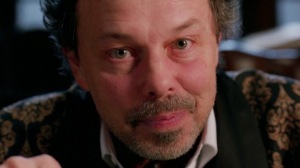 In memory of Shakespeare, who was born 450 years ago yesterday, (April 23, 1564), I thought I would write about the use of villains in stories. But I don’t want to write about Shakespeare’s villains, though he did create some fantastic bad guys. Instead, I want to talk about whether you need villains to make a story work.
In memory of Shakespeare, who was born 450 years ago yesterday, (April 23, 1564), I thought I would write about the use of villains in stories. But I don’t want to write about Shakespeare’s villains, though he did create some fantastic bad guys. Instead, I want to talk about whether you need villains to make a story work.
No matter what style of fiction you are writing, one of the biggest rules is that the story MUST have conflict. In a recent episode of Supernatural, Metatron said it well when he explained the following:
“The first rule of writer’s club is that you always steal from the best. Second rule is that every hero needs a villain,” (‘Meta Fiction,’ Supernatural, Season 9 Episode 18).
All the great writers, even Shakespeare, took the best stories of the era and made them better. In fact, the reason we’re still talking about Shakespeare almost 500 years later is because those stories he “borrowed” were so good and so reflective of the human experience that they stay prevalent century after century.
Are these stories strong on their own, or does the use of well thought-out villains make these stories so memorable?
Personally, I think villains get a lot of the credit for making a story memorable because of how people understand conflict.
Here is the basic formula for most good guy vs. bad guy stories:
Good guy must do/find something + bad guy gets in the way = CONFLICT
Half of the whole conflict equation is about the bad guy being an obstacle. We as readers need the villain to be the obstacle because we often put so much of ourselves into the hero. In other words, if the hero can beat the odds and come out victorious, so too can we.
But for the story to work, for the story to become an epic tale that captivates readers for centuries, does the villain have to be a person? Can you still have conflict without an easy-to-identify baddie?
Of course you can! However, do these non-villain stories have as much staying power as compared to stories with more obvious antagonists?
Let’s take a second and examine what types of stories often have no real antagonist.
Situational Stories
Although characters in situational stories are making choices to steer the plot, oftentimes there is no one person deliberately out to get anyone else. All the characters involved are making personal choices to handle each new situation, and the results of those choices simply play out on stage or on the page.
For example, in Love Actually (2003), we as viewers watch the oddly intermingled lives of multiple characters. Although some characters make morally questionable decisions that negatively affect those around them, there is no true antagonist. They’re all just people trying to find love, and the plot discusses how these people deal with all the obstacles involved on that journey.
Several of Jane Austen’s novels would fall into the situational stories category as well, especially Emma. In this Regency tale, we as the reader see how the main character, Emma, maneuvers through her social class as she tries to play matchmaker. She certainly dislikes some characters, and several of the characters are rude, but, once again, they’re all just regular folk making the best decisions they can to get what they want or what they feel they need.
Internal Struggle Pieces
 Most of these tales tend to be highly psychological and, more often than not, darker in subject matter. The movie Castaway (2000), for instance, shows how Chuck Noland (Tom Hanks) has been stranded on an island and somehow finds a way to survive for several years. To avoid going insane, or perhaps by going slightly insane, Noland turns a volleyball into something/someone he can talk to, and he calls the volleyball Wilson. Through his conversations with Wilson, which we as viewers only hear from Noland’s side of the argument, we start to see the internal struggles unfold. We particularly notice Noland’s fears of never being rescued and his thoughts about suicide. Through these conversations, Noland manages to overcome his personal demons, build a boat, and gets himself off the island.
Most of these tales tend to be highly psychological and, more often than not, darker in subject matter. The movie Castaway (2000), for instance, shows how Chuck Noland (Tom Hanks) has been stranded on an island and somehow finds a way to survive for several years. To avoid going insane, or perhaps by going slightly insane, Noland turns a volleyball into something/someone he can talk to, and he calls the volleyball Wilson. Through his conversations with Wilson, which we as viewers only hear from Noland’s side of the argument, we start to see the internal struggles unfold. We particularly notice Noland’s fears of never being rescued and his thoughts about suicide. Through these conversations, Noland manages to overcome his personal demons, build a boat, and gets himself off the island.
Coming-Of-Age Stories
Many of these stories focus on life lessons learned the hard way, and often show the main character going through the stages from childhood innocence into adulthood. Due to the nature of coming-of-age tales, the majority of stories focus on young adult main characters.
Although some of these stories have no real villains, such as Juno (2007) or The Perks of Being a Wallflower (2012), a lot of coming-of-age stories tend to have a definite antagonist. From a writer’s perspective, having someone for the hero to blame or fight makes the conflict more prevalent to the reader. It also makes the plot easier to construct in some ways.
With these three story type examples, among others not mentioned, we clearly have proven that you can have conflict sans villains, but the conflicts involved are often internal instead of external. They tend to focus on various aspects of the private human experience, such as dealing with social norms, identity struggles, and learning life lessons.
Stories without obvious baddies can also highlight a darker aspect of our reality. Namely, internal conflict stories showcase how we are our own worst enemies. Whether our own expectations are too high or whether we self-sabotage, internal conflict stories show people at their cruelest in terms of self-deprecation. Nevertheless, these stories can also show how people defeat or negotiate their way around their own demons.
Do Readers Prefer Obvious Villains?
Without significant market research, I can neither confirm nor deny any preferences. From my observations, however, there do seem to be far more stories with epic villains than those without.
 Pretty much all of Shakespeare’s plays have someone for the audience to hate, such as Iago, Edmund, or Richard III, which might show Shakespeare’s preference toward having villains. On the other hand, you could argue that MacBeth has no real villains, since both Macbeth and Lady Macbeth struggle more with their own bad choices and internal demons rather than with any external characters. Furthermore, as horrible as some of Shakespeare’s villains may be, it’s hard not to feel sympathy for such people as Shylock or Aaron the Moor, among others.
Pretty much all of Shakespeare’s plays have someone for the audience to hate, such as Iago, Edmund, or Richard III, which might show Shakespeare’s preference toward having villains. On the other hand, you could argue that MacBeth has no real villains, since both Macbeth and Lady Macbeth struggle more with their own bad choices and internal demons rather than with any external characters. Furthermore, as horrible as some of Shakespeare’s villains may be, it’s hard not to feel sympathy for such people as Shylock or Aaron the Moor, among others.
Some authors and readers may prefer stories with villains because the dichotomy of good vs. evil simplifies matters. According to the Aristotelian formula, good should triumph over evil and all the other details should be tied-up at the end so readers can have their moment of catharsis. Good vs. evil stories make the world appear black and white, even though we know life is far more muddled, complicated, and grey than we care to admit or imagine.
That desire for catharsis and escape may also explain why more stories have the protagonist vs. antagonist formula. In non-antagonist stories, readers who relate to the characters have to go through some hefty psychological issues. That type of self-analysis can make audiences uncomfortable, because often times the details are too close to home. Thus, instead of escaping reality through fiction, audience members must face the problems they share with the main characters.
To answer the question placed in the title of this article, the writer must first determine whether the plot will be discussing internalized subject matter. If so, a non-antagonist approach could work well. Going against the standard formula, however, does require more careful crafting in terms of plot, character development, and clues. Attacking an internalized plot as a writer also involves exploring some potentially dark places in your own psyche. In the end, if you can manage this change of pace, the results may mesmerize and surprise you.

